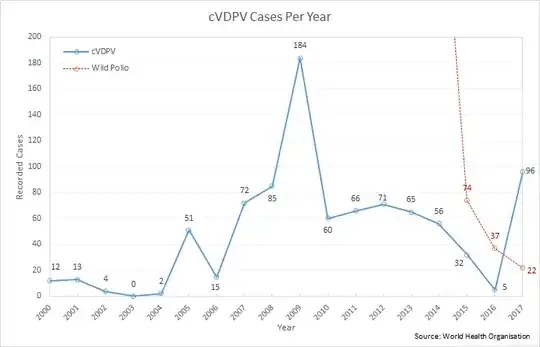Numbers not exact, ratio plausible. This is a success story.
The WHO provides a queryable database on AFP / polio. I am a bit unclear on the exact meaning of the headers, so I'll list the 2017 global totals for all columns:
- AFP (acute flaccid paralysis) cases: 104090
- Non polio AFP Rate: 5.46
- % Adequate stool collection: 89
- Pending: 118
- Wild poliovirus cases: 22
- cVDPV cases: 96
- Compatibles: 259
cVDPV stands for circulating vaccine-derived poliovirus.
So 96 cVDPV cases to 22 wild cases with 118 "pending" at least makes the claim's 21 to 6 cases plausible (assuming "at the point of writing").
This graph visualizes the progress of polio eradication:

(Tobus, Own work, CC BY-SA 4.0)
Note that cVDPV does not mean that the vaccinated person becomes ill. It means that viruses shedded by a freshly vaccinated person start infecting other, unvaccinated people. A fully vaccinated population would be immune from both types of polio.
Quoted from the WHO page, emphasis mine:
It takes a long time for a cVDPV to occur. Generally, the strain will have been allowed to circulate in an un- or under-immunized population for a period of at least 12 months. Circulating VDPVs occur when routine or supplementary immunization activities (SIAs) are poorly conducted and a population is left susceptible to poliovirus, whether from vaccine-derived or wild poliovirus. Hence, the problem is not with the vaccine itself, but low vaccination coverage. If a population is fully immunized, they will be protected against both vaccine-derived and wild polioviruses.
Since 2000, more than 10 billion doses of OPV have been administered to nearly 3 billion children worldwide. As a result, more than 13 million cases of polio have been prevented, and the disease has been reduced by more than 99%. During that time, 24 cVDPV outbreaks occurred in 21 countries, resulting in fewer than 760 VDPV cases.
Actually they felt they could remove the most problematic strain of the virus from the vaccination:
Until 2015, over 90% of cVDPV cases were due to the type 2 component in OPV. With the transmission of wild poliovirus type 2 already successfully interrupted since 1999, in April 2016 a switch was implemented from trivalent OPV to bivalent OPV in routine immunization programmes. The removal of the type 2 component of OPV is associated with significant public health benefits, including a reduction of the risk of cases of cVDPV2.
So allowing for the latency mentioned for cVDPV to actually occur, vaccine-derived polio cases can be expected to go down as well.
